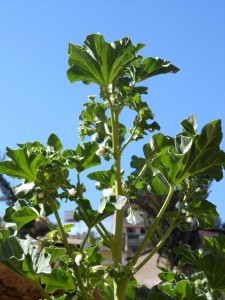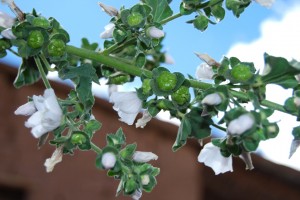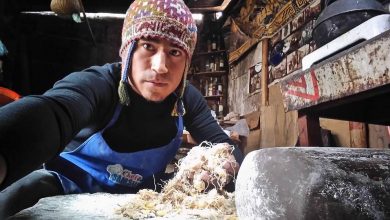White Mallow, Beauty and Health

Like a flash of light, the white mallow glows against dark green foliage. This plant is a blessing in these times for the people of Cuzco when cold rules at night and many people have symptoms of flu since it both calms and cures sicknesses such as fever and internal heat. In other places its leaves, flowers, and seeds also find uses as food.
From Europe, the white mallow, or malva blanca as it is called here, came to the New World. But it is also found in Western Asia and North Africa. It was introduced into Central and North America as well as South America. In Cuzco, though others might use it for food, it is considered a medicinal plant.
In the fall its seeds are sown directly on the soil. Its seeds are easy to gather and to save since one can pull them right off the dried plants.
The white mallow plant lives for a long time and can reach up to two meters in height. Generally it stands upright and develops branches. Its stem can become quite hard and as thick as a good sized eucalyptus branch.
The young leaves of the mallow plant can be eaten raw. Some people say they have a gentle flavor and can be a substitute for lettuce. The older leaves are better cooked as a boiled green. The mallow’s flowers appear abundantly and they too can be eaten in salads. Intriguingly, this form of using the plant is found in Asia and North Africa.

The flowers are either pink or white and appear from midsummer until the beginning of fall, more or less. Growing in a helix shaped cluster on the branches, the flowers measure from two to six cms. in diameter. The flowers offer you peace and tranquility.
At night the flowers close just as they do when it is cloudy or stormy. They do this in order to protect their pollen. Even though these flowers are capable of self pollinating, since they are hermaphrodite, most pollination occurs because insects transport it from one flower to another.

The White mallow’s fruit is reminiscent of a tangerine, although much smaller in size. It is a small bundle of seeds, like a capsule. Generally the seeds spread through gravity; they fall to the earth when mature.
Mallow grows abundantly. Not only is it actively grown, it appears in vacant lots, as a weed in gardens, and on the edges of roads and gardens that are not cared for.
White Mallow is sold in the different markets of Cuzco at a very reasonable price. It costs per bundle around S/.50.
It can be purchased from any of the vendors of herbs who are found either within the markets or at their doors. The herb vendors both sell and help people make sense of what bothers them so that they can find the proper herb as a remedy. The herbalists are always there to help us.
In Cuzco this plant is mostly grown in the rural areas of the valley, that is in the upper areas.
Though elsewhere it is eaten, here mallow leaves are generally used in the form of a tea in order to reduce a fever. One drinks two or three cups of the mallow tea per day. People will also give themselves therapeutic baths with mallow.

The flowers are used in the same way as a popular medicine. Mallow is claimed to have purifying properties that are good for the colon and can be a supplement to help people lose weight.
Once, while I was in a work meeting and was talking about the importance of this plant, my colleague said that when he was little his mother would wash his head with water steeped in mallow, while holding him in her arms, in order to calm his internal heat.
This plant is considered valuable in Cuzco as a medicinal herb. People rely on it frequently to better their health.




